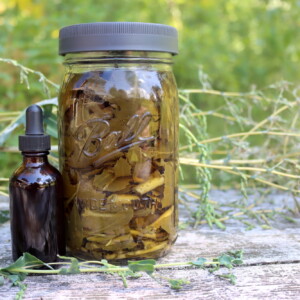
Wild Lettuce Tincture
Wild lettuce tincture is commonly made for its sedative and pain-relieving compounds, making it a potent addition to your herbal medicine cabinet.
Equipment
- Small Tincture Funnel Optional
- Cheesecloth, Fine Mesh (90 grade) or fine mesh strainer
- Amber Glass Tincture Bottles (with droppers) for Storage
Ingredients
- Fresh wild lettuce plants in the ground, not dried
- High-proof alcohol vodka, rum, or brandy
Instructions
Harvesting the Wild Lettuce for Tincture
The key to making an effective wild lettuce tincture lies in the gradual extraction of the latex-like sap from the plant. The process requires a series of small cuts down the stem of each wild lettuce stalk to release the sap slowly. Here’s how to harvest the wild lettuce for the best medicinal effect:
- Select healthy, mature wild lettuce plants that are still growing in the ground. Ideally, these plants should be at least 2-3 feet tall (though in shorter growing seasons, they may be smaller). Avoid harvesting plants that are too young or already flowering, as their sap content may be lower.
- Start by cutting off the flowers from each plant. These are typically discarded as they don’t contain the latex. Then, with sharp shears or pruning scissors, begin the process of decapitating the plant by cutting about half an inch down the stalk. This allows the sap to ooze out. Leave the plant in the ground, as the latex is transported up from the roots, and it needs time to travel through the stem.
- After cutting the stalk, allow the sap to ooze out and dry for a short period (around 10-15 minutes). Once it starts to harden slightly, scrape the sap off with a clean knife or spatula. You can either collect the dried sap in a small bowl or directly place the sticky pieces into your tincture jar.
- Continue to cut another half-inch section of the stalk every few minutes, allowing the sap to ooze and dry each time. As the plant becomes shorter and less productive, you will eventually cut it down to about 12 inches in height, and at this point, the plant can be considered fully "bled."
- It’s important to spread out the harvesting over an extended period, with 30 to 60 seconds between each cut. The process of bleeding the plant should not be rushed. For best results, you will need to repeat this process on the plant until it has released as much sap as possible, gradually reducing it to a small, headless stalk.
Preparing the Tincture
- Once you have gathered enough sap filled snippings of wild lettuce, you can proceed with the tincture-making process.
- Add your plant cuttings to your clean mason jar. You’ll want the jar to be about 2/3rds full of wild lettuce trimmings.
- Pour your choice of high-proof alcohol into the jar to fully cover the plant material. Vodka is commonly used, but rum or brandy can also be suitable. Ensure that the sap is completely submerged in the alcohol to allow for full extraction of the medicinal properties. Aim for at least 60-proof alcohol (30% alcohol by volume) to ensure adequate preservation of the tincture.
- Secure the lid tightly and give the jar a gentle shake to mix the alcohol with the sap. The mixture may not look very uniform at first, as the sap will be sticky, but over time, it will dissolve into the alcohol.
- Place the jar in a cool, dark place (a cupboard or pantry works well). For the next 4 to 6 weeks, allow the tincture to sit and infuse. Shake the jar gently every 2-3 days to ensure the sap continues to dissolve into the alcohol.
- After 4 to 6 weeks, the tincture should be ready. Set up a funnel lined with cheesecloth or use a fine mesh strainer to filter out any remaining plant material and solids. Pour the tincture through the funnel into a dark glass tincture bottle. Gently press the plant matter to extract as much liquid as possible.
- Be sure to label your tincture with the name of the herb, the date it was made, and any other relevant information. Store the finished wild lettuce tincture in a cool, dark place. It can last for 18 to 24 months when stored properly.
Notes
Wild lettuce tincture is most often used for its mild sedative effects and pain-relieving properties. It is commonly used as a natural alternative for anxiety, insomnia, and muscle spasms. Here’s how you can use it:
For Sleep and Relaxation: Wild lettuce tincture is commonly used for its calming effects.
Pain Relief: Due to its mild analgesic properties, wild lettuce tincture can also help with chronic pain or muscle spasms.
For Cough and Respiratory Support: Some use wild lettuce tincture for its soothing effects on the respiratory system.
For accurate dosage, you’d have to speak to a clinical herbalist, as this can be very personal based on your constitution. Generally, most people start with around ½ to 1 dropper full, but that can vary based on your constitution and your goals.
Harvesting Considerations
Wild lettuce harvesting is time-intensive and requires patience, but it’s crucial for getting the highest-quality sap. Be sure to take the time to bleed the plants slowly and follow the traditional method to get the most potent latex for tincture-making.Alcohol-Free Option
If you prefer to avoid alcohol, you can also make a glycerite tincture using vegetable glycerin and distilled water. Use a ratio of 3 parts glycerin to 1 part water for dried wild lettuce. For fresh wild lettuce, use 100% glycerin. Shake daily and strain after 4 to 6 weeks. Tried this recipe?Let us know how it was!